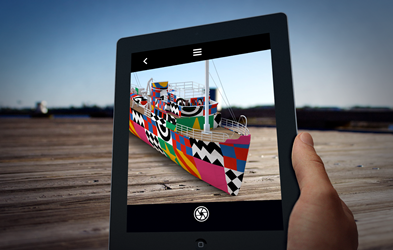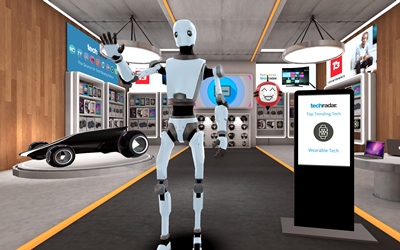The virtual and augmented reality gold-rush
Dom Raban is the MD of Corporation Pop, a digital innovation agency. He has been creating ‘stuff’ for nearly 40 years, from punk fanzines in the 1970s to content for emerging technology platforms now. Currently Corporation Pop are working on several Augmented Reality (AR) and Virtual Reality (VR) projects, including an app for child patients that helps reduce the stress associated with hospitalisation by increasing familiarisation with staff, environments and procedures.
![]()
Dom is a member of the VRARA Digital Health Committee. The VRARA is the global industry association for Virtual Reality, Augmented Reality, and Mixed Reality.

There has been a lot of discussion and excitement in the media recently about the possibilities of these new technologies and we thought Bermans contacts would benefit from reading some real insight into the industry from an expert and to get you thinking about how this could assist your business.
When my agency was in its infancy we designed and built websites. Nothing unusual about that, but this was in the very early days of the web when Netscape Navigator was the browser of choice and Google was just a glint in Larry Page’s eye. When new business enquiries came in they often went something like this:
[CORPORATION POP] Hi, how can we help?
[CUSTOMER] I need a website?
[CORPORATION POP] Great. We can help with that, but can you just tell us why you need a website?
[CUSTOMER] I don’t know, but everyone else is getting one…
We’re at a similar, gold-rush stage with augmented and virtual reality. AR and VR can provide truly amazing, liberating, deeply engaging and sometimes business-changing ways in which you can build deeper relationships with your customers but you need to be clear about what you want to achieve and why.
The point is, that in the early stages of any technology the hardware is usually way ahead of the content and when the content isn’t there, then neither are the users. This leads to what Gartner’s now famous hype cycle describes as the ‘peak of inflated expectations’. And if you’re not careful, an ill-conceived foray in to AR or VR will almost certainly leave you in the ‘trough of disillusionment.’
For these reasons it is vitally important that the content you deliver is meaningful, pleasurable and accessible.
‘Meaningful’ because anything else is just technology for technology’s sake. It is a fairly safe assumption that for the majority of users, engaging with AR or VR content will be a new, or fairly new, experience. Putting on a headset or viewing a digitally manipulated world via the screen of a mobile device is a change from ‘normal’ behaviour. You need to ask, ‘Does the perceived benefit of engaging with your content outweigh the friction of the change in behaviour?’ If it doesn’t then you are not providing a meaningful experience that adds value to your proposition.
‘Pleasurable’ because the memory of the experience will live with the user beyond the duration of the interaction. Interacting with augmented, mixed or virtual reality scenes can be immensely rewarding, allowing you to view the world in new and surprising ways. I love watching new users gasp in appreciative awe when they experience VR or AR for the first time. Eliciting this kind of response provides lasting value, creating a deep connection with your content, and is fiendishly hard to do with almost any other medium.
Conversely though, leaving the user feeling disorientated or (worse) nauseous will leave a long-lasting impression of entirely the wrong kind. Motion sickness is a common problem in poorly conceived VR experiences. It is caused by a disconnect between what the user sees and what they think they should be seeing. Fortunately it is easy for any experienced VR developer to design around the problem so make sure that comfort and pleasure are at the top of the list of requirements when commissioning any VR or AR project.
‘Accessible’ because the technology should not get in the way of the experience. You should consider where your users will be and what devices will be at hand when they interact with your content. You can then choose a technology platform that is appropriate for the intended use.
For VR in particular choice of hardware is key. Currently there is still very low ownership of VR headsets and no common content standard between manufacturers. An experience designed for one proprietary headset is unlikely to work on another. Unfortunately too, there is an inverse relationship between quality of experience and ease of access. The most visually rich experiences are designed for ‘tethered’ headsets like Oculus Rift and HTC Vive. These need to be wired to a high performance PC and use tripod or wall-mounted sensors to track your motion. This kind of experience is most appropriate for environments such as exhibitions, training centres or classrooms where you can control the installation and bring the user to the experience. At the other end of the scale Google Cardboard provides a very cheap and highly portable solution that will work with almost any smart phone. The low cost and ubiquity of smart phones may make this a viable option when you need to reach a large number of users who are geographically dispersed but beware of the payoff in quality (or rather, lack of it!).
At present almost all consumer AR is experienced without a headset and uses the camera of your smartphone. This means that AR is less device dependent than VR and therefore it is easier to reach large audiences with quality content. However it usually requires the user to download a bespoke application so you need to factor in the high development costs of building cross-platform apps if you want to target both Android and iOS users.

In order to experience your augmented reality content you are asking users to go to the trouble of visiting an app store, finding and downloading a new app and then getting to grips with its use. For this reason it is even more important that your content is ‘meaningful’, so that the user is compensated for their effort.
One of the most exciting recent developments in both AR and VR is the move towards web-based experiences. This will democratise content delivery by allowing users to experience immersive content without the need to download a bespoke app. Currently browser support is very limited and the technology is in its infancy but by next year I expect that Web AR and VR will provide a viable and more accessible alternative to current approaches.
In the next 2-3 years we will see the widespread use of consumer-ready mixed reality headsets that allow you to view the real world, augmented with computer generated content. Microsoft’s Hololens already does this but the unwieldy headset and hefty price tag of around $3,000 limits its use. Meanwhile the much vaunted and heavily funded Magic Leap promises to revolutionise the way we see the world but its plans are shrouded in secrecy.
Then there is Apple. Rumours abound about what their next move will be but CEO Tim Cook recently said, ‘I regard it as a big idea, like the smartphone. The smartphone is for everyone, we don’t have to think the iPhone is about a certain demographic, or country or vertical market: it’s for everyone. I think AR is that big, it’s huge. I get excited because of the things that could be done that could improve a lot of lives.’ Expect the iPhone 8 to expose the first public face of Apple’s investment in AR and, no doubt, disrupt the market in the same way that the first iPhone did.
Right now, thousands of companies, across all sectors, are finding ways in which to use these emerging technologies to transform their businesses. Some of the most compelling examples can be found in the health, training and education sectors where lives are being changed by experiences that are ‘meaningful, pleasurable and accessible’.
Every day I see examples from around the world of how these technologies are changing lives. One of my favourites, that I think demonstrates the power of VR beautifully simply, is this video which shows how elderly residents at an old people’s home reacted to their first VR experience.

Just as in the early days of the web, costly mistakes will and are being made by companies that rush headlong in to this emerging technology space. But if you are prepared, and understand that technology is a means and not an end, then now is the time to discover the massive opportunities that AR and VR presents.
If you would like to discuss how VR and AR could help your business then contact Dom:
t: 0161 838 0808
e:dom@corporationpop.co.uk
w: https://corporationpop.co.uk/ Twitter: @corporationpop Connect on:LinkedIn
You can read the full version of this article on Corporation Pop’s website.
 |
| 
